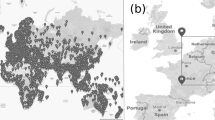Abstract
We investigate the current state of Internet infrastructures by examining the position and the number of routers considering various demographic data. The scaling relation between the router and the population densities is studied in two different scales, one is a worldwide scale and the other is a country scale. We found the number of routers in each country to be proportional to its economic level, and a super-linear scaling relation to exist between the router density and the Internet user density on a worldwide level. From a district analysis of the country level, we found that the scaling exponents change according to economic conditions and the level of Internet development. As the Internet penetration rate increases, the scaling exponent tends to be close to 2/3, indicating that routers are distributed like public facilities.
Similar content being viewed by others
References
A. Dhamdhere and C. Dovrolis, in Proceedings of the 8th ACM SIGCOMM Conference on Internet Measurement 2008 (Vouliagmeni, Greece, October 20–22, 2008).
B. Carpenter, Comput. Commun. Rev. 39, 6 (2009).
Available: http://www.totaltele.com/view.aspx?ID=44-8681.
V. V. Gehring, The Internet in Public Life (Rowman & Littlefield, Lanham, Maryland, 2004), p. 79.
L. M. A. Bettencourt, J. Lobo, D. Helbing, C. Kühnert and G. B. West, Proc. Natl. Acad. Sci. U.S.A. 104, 7301 (2009).
G. E. Stephan, J. Regional Sci. 28, 29 (1988).
M. Gastner and M. E. J. Newman, Phys. Rev. E 74, 016117 (2006).
J. Um, S. W. Son, S. I. Lee, H. Jeong and B. J. Kim, Proc. Natl. Acad. Sci. U.S.A. 106, 14236 (2009).
A. Lakhina, J. W. Byers, M. Crovella and I. Matta, IEEE J. Sel. Areas Commun 21, 934 (2003).
S. H. Yook, H. Jeong and A. L. Barabási, Proc. Natl. Acad. Sci. U.S.A. 99, 13382 (2002).
We used the data at March 2, 2010, from http://www.maxmind.com/app/city.
Available: http://developer.yahoo.com/geo/placefinder/.
Available: http://www.internetworldstats.com/list2.htm.
Available: http://www.imf.org/external/data.htm.
Available: http://www.itu.int/ITU-D/ict/statistics/.
Available: http://sms.nespot.com/english/web/index.html.
Available: http://corp.fon.com/en/.
Available: http://chartsbin.com/view/2484.
Author information
Authors and Affiliations
Corresponding author
Rights and permissions
About this article
Cite this article
Kim, D., Son, SW. & Jeong, H. Demographic studies of Internet routers. Journal of the Korean Physical Society 60, 585–589 (2012). https://doi.org/10.3938/jkps.60.585
Received:
Accepted:
Published:
Issue Date:
DOI: https://doi.org/10.3938/jkps.60.585




